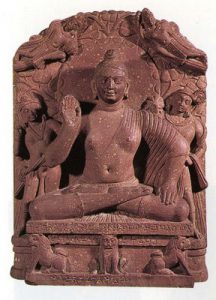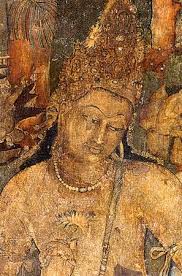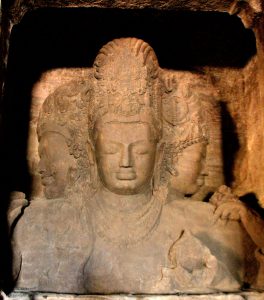Subject: History Category: Art and Culture Topic: Post-Mauryan Trends in Indian Art and Architecture – Part III
NCERT notes on important topics for the UPSC civil services exam preparation. These notes will also be useful for other competitive exams like banking PO, SSC, state civil services exams and so on.
Post-Mauryan Trends in Indian Art and Architecture-Part III (UPSC Notes):- Download PDF Here

- Period: 2nd century AD.
- Buddha with two Boddhisattva attendants. Buddha is seated in Padmasana (cross-folded legs).
- Right hand is in Abhayamudra raised above the shoulder level and left hand is on the left thigh.
- Ushanisha (hair knot) is vertically raised. S
- culptures of this period from Mathura have light volume and a fleshy body.
- The sanghati (dress) covers only the left shoulder.
- Buddha is seated on a lion throne. He has a large halo which is decorated with geometric motifs. His face is rounded having fleshy cheeks.
- The attendants are identified as the Boddhisattvas Padmapani (holding a lotus) and Vajrapani (holding a thunderbolt).
- Two flying figures diagonally above the halo.
- This image is important for an understanding of the Buddha image development in the later periods.
Also, check out the Arts of the Mauryan Period on the given link.
Aspirants can check the following links to align their preparation for UPSC 2023 examination:
|

- Period: 2nd century AD, Kushana Period.
- Taxila in Gandhara region, now in Pakistan.
- The sculpture has Greco-Roman elements. Buddha’s head has Hellenistic elements.
- Thick curly hair with sharp and linear strokes over the head. Big forehead plane, protruding eyeballs, half-closed eyes.
- Face and cheeks are not rotund unlike the images found in other parts of the country.
- Elongated ears and earlobes; Surface is smooth and the outlines are quite sharp.
- Expressive image; shows a remarkably calm expression.
- Gandhara images of this period showcase heaviness. This style assimilates influences from Parthian, Bactrian and Acamenian traditions with the local style.

- Period: 5th century AD.
- Fine example of the Sarnath School.
- Made from Chunar sandstone.
- Buddha is seated in Padmasana.
- Image represents dhammachackrapravartana which is evident from the figures in the panel below the throne. The panel has a chakra in the centre and a deer on each side. Buddha’s hands are also shown in dhammachackrapravartana mudra placed below the chest.
- Body is slender and slightly elongated. The outlines are delicate and rhythmic.
- The robe clings to the body. Face is round although the cheeks are less rounded as compared to the earlier images from the Kushana period. Lower lip is protruding. Eyes are half-closed.
- Ushanisha has circular curled hairs.
- The back of the throne is richly decorated with carvings of creepers and flowers. The halo is plain.
Candidates preparing for upcoming UPSC examinations can check the following relevant links to prepare comprehensively –

- Located in Ajanta Cave No.1.
- Period: Late 5th century AD.
- Image of a Boddhisattva holding a Padma or lotus.
- Large shouldered with 3 bends in the body creating the impression of a movement.
- Soft modelling, outlines merged with the body creating a 3-D effect.
- Eyes are half-closed and a bit elongated. Nose is straight and sharp. Small chin.
- Adorning a beaded necklace.
- Right hand is holding the lotus and the left hand is extended into space.
- Small figures surround the image.
- Thread over the body is seen with spiral lines.
- Colours used: light red, green, brown and blue.
- Cave No.1 paintings are better preserved.

- Location: Cave No.26, Ajanta Caves.
- The theme of this image has been portrayed as paintings in the caves but this is the only sculpture.
- Image of Buddha in the centre surrounded by Mara’s army and his daughter.
- Buddha is in padmasana.
- Mara represents desire here. This representation is the personification of the tumult of mind that the Buddha underwent at the time of his enlightenment.
- Buddha’s right hand is shown towards the earth symbolising his generosity.
- The panel contains many highly voluminous images.

- Period: Early 6th century AD.
- Located in the main cave shrine at Elephanta Caves.
- Best example of sculpting images in rock-cut caves in the western Deccan tradition.
- Large image. Central head is of Shiva. Other two heads are of Bhairava and Uma.
- Central face is round with thick lips and heavy eyelids.
- The face of Bhairava in the profile is shown in anger with bulging eye and moustache.
- Uma’s face has feminine features.
- This image is considered as a representation of the five integrated faces of Shiva mentioned in one of the Shilpa texts. The top and the back heads are invisible.
- Characteristic features of the sculptures of the Elephanta Caves: smooth surface, elongation and rhythmic movement.
Post-Mauryan Trends in Indian Art and Architecture-Part III (UPSC Notes):- Download PDF Here
Also See | NCERT Notes: Post-Mauryan Trends in Indian Art and Architecture – Part I
Aspirants can visit the UPSC Syllabus page to familiarise themselves with the topics generally asked in the exam. For further assistance visit the following links –
Comments